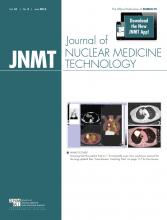A 62-y-old woman was found to have a lung mass and a brain mass. The brain mass was resected, and the histopathologic findings were suggestive of a gastrointestinal primary tumor with neuroendocrine features. She was referred for an 111In-octreotide SPECT/CT scan to evaluate for somatostatin-avid disease.
After injection of 222 MBq (6 mCi) of 111In-octreotide, planar SPECT images (Fig. 1A) and correlative CT images (Fig. 1B) of the chest were acquired in the anterior and posterior projections at the end of 4 h and 24 h. SPECT of the chest was also performed at the end of 24 h. An 18F-FDG PET/CT scan (Fig. 1C) had been obtained 2 wk previously.
(A) SPECT/CT scan obtained 24 h after injection of 222 MBq of 111In-octreotide. (B) Correlative CT scan of chest. (C) 18F-FDG PET/CT scan obtained 2 wk before 111In-octreotide SPECT/CT scan.
QUESTION 1
On the basis of the 111In-octreotide scan and correlative CT, what is the best interpretation of this study?
111In-octreotide–avid tumor in the right lung and inflammatory changes bilaterally.
Inflammatory changes.
Normal findings.
None of the above.
QUESTION 2
What are the causes of abnormal 111In-octreotide uptake in the lungs in addition to 111In-octreotide–avid tumors?
Infections.
Sarcoidosis.
Inflammatory conditions.
All of the above.
CASE DISCUSSION
The scan of this patient showed a single focus of intense uptake in the right lung and diffuse mild uptake in the rest of the lung tissue bilaterally. The corresponding CT scan showed a tumor in the region of intense uptake and centrilobular emphysema in the rest of the lungs bilaterally. The previously obtained 18F-FDG PET/CT scan showed intense uptake within the tumor but did not demonstrate abnormal diffuse uptake bilaterally within the emphysema.
Somatostatin is a naturally occurring neuropeptide. Somatostatin receptors are found in many tumors, including pituitary adenomas, islet cell tumors, neuroblastomas, pheochromocytomas, small cell carcinoma of the lung, paragangliomas, carcinoid, medullary carcinoma of the thyroid, meningiomas, astrocytomas, lymphoma, Merkel cell tumors, and breast cancer. Also, somatostatin receptors are found in activated leukocytes in granulomatous processes such as sarcoid, tuberculosis, and chronic inflammatory processes (inflammatory bowel disease, rheumatoid arthritis).
A 111In-octreotide scan normally shows activity in the thyroid gland, liver, gallbladder, spleen, bowel, kidneys, and urinary bladder. 111In-octreotide uptake in the lung previously has been reported in infections (lung abscess, pneumonia), sarcoidosis, hypersensitivity pneumonitis from pigeon antigens, and radiation fibrosis, in addition to 111In-octreotide–avid tumors. The uptake is possibly due to activated cells, mainly macrophages within the granulomas and in the alveoli, expressing somatostatin receptors.
Footnotes
Published online Apr. 23, 2013.
↵* For the answers, see page 120.








